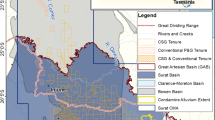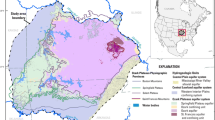Abstract
Understanding groundwater use, both current and historical, is important for understanding the hydrogeology of groundwater systems, and for water planning. The Queensland portion of Australia’s Great Artesian Basin (GAB) is managed under the Water Plan (Great Artesian Basin and Other Regional Aquifers) 2017. Methods were developed to estimate current and historical abstractions from the different hydrostratigraphic units of the basin. In the first stage, source aquifers were assigned to ~96,000 bores within the Queensland GAB footprint. Of these, 31,503 bores were assigned directly to the GAB, with other bores sourcing groundwater from units above or below the GAB. In the second stage, current groundwater use for all bores and historic groundwater-use trends were estimated, covering the 115-year period between 1900 and 2015. These estimates took account of periods of inactivity at the bore, the aquifer condition (sub-artesian, artesian), and the nature of discharge (controlled or uncontrolled). The process used publicly available datasets. This paper presents an overview of the methodology and how the estimates were used to support water planning. The current groundwater use from the GAB in Queensland was estimated to be 322 GL/year, which is lower than previous estimates, partly because of improved estimation techniques, the bore capping and piping programs that have been in progress since 1989, and the naturally reducing discharge rates from uncontrolled artesian bores.
Résumé
Comprendre l’utilisation des eaux souterraines, aussi bien actuelle qu’historique, est important pour la compréhension de l’hydrogéologie des systèmes et pour la planification de l’eau. La partie du Grand Bassin Artésien (GBA) d’Australie située au Queensland est gérée par le Water Plan 2017 (Grand Bassin Artésien et Autres Aquifères Régionaux). Des méthodes ont été développées pour estimer les extractions actuelles et historiques dans les différentes unités hydrostratigraphiques du bassin. Dans une première étape, les aquifères source ont été affectés à ~96,000 forages situés dans l’emprise du GBA du Queensland. Sur ce nombre, 31,503 forages ont été attribués directement au GBA, d’autres forages s’approvisionnant en eaux souterraines à partir des unités situées au-dessus et au-dessous du GBA. Dans une deuxième étape, l’utilisation actuelle des eaux souterraines de tous les forages et les tendances historiques de l’utilisation des eaux souterraines ont été estimées, pour la période de 115 ans comprise entre 1900 et 2015. Ces estimations prennent en compte des périodes d’inactivité du forage, le régime de l’aquifère (sub-artésien, artésien), et le type de décharge (contrôlée ou non contrôlée). La méthode a utilisé les bases de données accessibles au public. Le présent article donne une vue d’ensemble de la méthodologie et indique comment les estimations ont été utilisées pour aider à la planification de l’eau. L’utilisation actuelle de l’eau souterraine issue du GBA dans le Queensland a été estimée à 322 GL/an, ce qui est moins que les précédentes estimations, en partie à cause de techniques d’estimation améliorées, des programmes de fermeture et de raccordement des forages en cours depuis 1989, et de la réduction naturelle des taux de décharge à partir des forages artésiens non contrôlés.
Resumen
Para entender la hidrogeología de los sistemas de agua subterránea, y la planificación de los recursos hídricos es importante comprender el uso del agua subterránea, tanto actual como histórico. La porción de Queensland de la Great Artesian Basin de Australia (GAB, por sus siglas en inglés) es administrada bajo el Plan de Agua 2017 (Great Artesian Basin and Other Regional Aquifers). Se desarrollaron métodos para estimar las extracciones actuales e históricas de las diferentes unidades hidroestratigráficas de la cuenca. En la primera etapa, los acuíferos se asignaron a ~96,000 pozos dentro de la zona de GAB de Queensland. De estos, 31,503 pozos fueron asignados directamente al GAB, con otros pozos que se abastecen de agua subterránea de unidades por encima o por debajo del GAB. En la segunda etapa, se estimó el uso actual del agua subterránea para todas las perforaciones y las tendencias históricas de uso del agua subterránea, cubriendo el período de 115 años entre 1900 y 2015. En estas estimaciones se tuvieron en cuenta los períodos de inactividad en el pozo, la condición del acuífero (subartesiano, artesiano) y la naturaleza de la descarga (controlada o no controlada). El proceso utilizó conjuntos de datos disponibles públicamente. Este documento presenta una visión general de la metodología y de cómo se utilizaron las estimaciones para apoyar la planificación hídrica. El uso actual del agua subterránea del GAB en Queensland se estimó en 322 GL/año, lo cual es inferior a las estimaciones anteriores, en parte debido a la mejora de las técnicas de estimación, los programas de limitación de los pozos y las tuberías que han estado en marcha desde 1989, y la reducción natural de los caudales de los pozos artesianos no controlados.
摘要
了解当前和历史的地下水利用状况对于理解地下水系统的水文地质和进行水计划非常重要。澳大利亚的大自流盆地(GAB)的昆士兰部分是根据2017年水计划(大自流盆地和其他区域含水层)进行管理的。本研究开发了估算该盆地不同水文地质单元的当前和历史开采量的方法。在第一阶段,在昆士兰州GAB足迹内将开采来源含水层分配给约96,000个钻孔。其中,有31,503个钻孔直接分配给GAB,其他钻孔则在GAB上方或下方的单元中抽取地下水。在第二阶段,估算了所有钻孔当前地下水使用量和历史地下水利用趋势,涵盖了从1900至2015年的115年。这些估算考虑了钻孔的不活动时间段,含水层条件(亚自流,自流),以及排泄特点(受控或不受控制)。该过程使用了公开可用的数据集。本文概述了该方法,以及如何使用这些估计来支持水计划。昆士兰州GAB当前的地下水利用量估计为322 GL/年,低于先前的估计值,部分是因为自1989年以来估算技术改进,正在进行的井盖和管道计划,以及非控制自流井中天然减少的排泄量。
Resumo
Compreender o uso das águas subterrâneas, tanto atual como histórico, é importante para a compreensão da hidrogeologia dos sistemas de águas subterrâneas e para o planejamento hídrico. A porção de Queensland da Grande Bacia Artesiana da Austrália (GBA) é gerenciada pelo Plano de Água 2017 (Grande Bacia Artesiana e outros aquíferos regionais). Métodos foram desenvolvidos para estimar captações atuais e históricas das diferentes unidades hidroestratigráficas da bacia hidrográfica. Na primeira etapa, aquíferos foram caracterizados por ~ 96,000 furos dentro da pegada de Queensland na GBA. Destes, 31,503 furos foram atribuídos diretamente à GBA, tendo outros furos fontes de água subterrânea de unidades acima ou abaixo da GBA. Na segunda etapa, o uso atual de águas subterrâneas para todos os furos e tendências históricas de uso de águas subterrâneas foram estimados, abrangendo o período de 115 anos entre 1900 e 2015. Essas estimativas levaram em conta os períodos de inatividade no furo, a condição de aquífero (subartesiano, artesiano) e a natureza da vazão (controlada ou não controlada). O processo usou conjuntos de dados disponíveis publicamente. Este artigo apresenta uma visão geral da metodologia e como as estimativas foram utilizadas para subsidiar o planejamento hídrico. O uso atual de águas subterrâneas da GBA em Queensland foi estimado em 322 gal/ano, menor do que as estimativas anteriores, em parte devido a melhores técnicas de estimativa, os programas de nivelamento e tubulação do furo que estiveram em andamento desde 1989, e a natural redução das taxas de vazão dos furos artesianos não controlados.













Similar content being viewed by others
References
Bandler H (1995) Water resources exploitation in Australian prehistory environment. The Environmentalist 15:97–107
Blake T, Cook M (2006) Great Artesian Basin historical overview. Queensland Dept. of Natural Resources Mines and Water, Brisbane, Australia
Business Queensland (2019) Improving Great Artesian Basin water use efficiency. Business Queensland, Brisbane, Australia
CQCHM (Central Queensland Cultural Heritage Management) (2005) Statement concerning the cultural heritage values and places associated with Great Artesian Basin springs Queensland. Queensland Dept. of Natural Resources Mines and Water, Brisbane, Australia
CSIRO (1974) Lands of the Balonne-Maranoa area, Queensland. CISRO, Canberra
DNRM (2005) Hydrogeological framework report for the GAB WRP area: version 1.0. Dept. of Natural Resources and Mines, Brisbane, Australia
DNRM (2017) Great Artesian Basin and other regional aquifers water plan. Minister’s Considerations Report September 2017, Dept. of Natural Resources and Mines, Brisbane, Australia
DNRME (2019) Queensland groundwater database: February 2019. https://data.qld.gov.au/dataset/groundwater-database--json. Accessed November 2019
Fensham R, Fairfax R (2005) Great Artesian Basin water resource plan ecological assessment of GAB springs in Queensland. Dept. of Natural Resources and Mines, Brisbane, Australia, 27 pp
GABCC (Great Artesian Basin Consultative Council) (1998) Great Artesian Basin Resource Study. GABCC, Brisbane, Australia
GABCC (Great Artesian Basin consultative council) (2000) Great Artesian Basin Strategic Management Plan. GABCC, Brisbane, Australia
Habermehl M (2019) Review: The evolving understanding of the Great Artesian Basin (Australia), from discovery to current hydrogeological interpretations. Hydrogeol J. https://doi.org/10.1007/s10040-019-02036-6
Hazel CP (1991) Great Artesian Basin rehabilitation program. Water Resources Commission, Department of Primary Industries, Brisbane, Australia, 9 pp
Humphries P (2007) Historical indigenous use of aquatic resources in Australia’s Murray-Darling Basin, and its implications for river management. Ecological Management and Restoration, vol 8, no. 2, Ecological Society of Australia, Windsor, Australia
Keir G, Bulovic N, McIntyre N (2019) Stochastic Modeling of Groundwater Extractions over a Data-Sparse Region of Australia. Groundwater 57 (1):97–109
Kodric-Brown A, Brown JH (2007) Native fishes, exotic mammals, and the conservation of desert springs. Front Ecol Environ5(1):549–553
Konikow L, Leake S (2014) Depletion and capture: revisiting “the source of water derived from Wells”. Groundwater 52. https://doi.org/10.1111/gwat.12204
Lynham A (2017) Palaszczuk Govt brings more water funds to table [Media release]. http://statements.qld.gov.au/Statement/2017/6/13/palaszczuk-govt-brings-more-water-funds-to-table. Accessed 11 September 2019
Marshall V (2017) Overturning aqua nullius: securing aboriginal water rights. Australian Institute of Aboriginal and Torres Strait Islander Studies, Aboriginal Studies Press, Canberra
Munro NT, Kovac K, Niejalke D, Cunningham RB (2009) The effect of a single burn event on the aquatic invertebrates in artesian springs. Austral Ecol 34(8):837–847
OGIA (2016a) Hydrogeological conceptualisation report for the Surat cumulative management area. The Office of Groundwater Impact Assessment, Brisbane, Australia
OGIA (2016b) Underground water impact report for the Surat cumulative management area. The Office of Groundwater Impact Assessment, Brisbane
Parsons Brinkerhoff (2011) Queensland Murray-Darling basin: methodology for estimating the take of groundwater for stock and domestic purposes. Parsons Brinkerhoff, New York
Pascoe B (2018) Dark emu. Magabala Books, Djugun, Australia
Queensland Government (2017) Water plan (Great Artesian Basin and other regional aquifers). https://wwwlegislationqldgovau/view/html/inforce/current/sl-2017-0164 Accessed 11 September 2019
Queensland Government (2019a) Petroleum and gas production and reserve statistics. Queensland Government, Brisbane, Australia
Queensland Government (2019b) Water Act 2000 (Queensland). https://www.legislation.qld.gov.au/view/html/inforce/current/act-2000-034. Accessed 11 September 2019
Ransley T, Smerdon B (2012) Hydrostratigraphy, hydrogeology and system conceptualisation of the Great Artesian Basin. CSIRO, Canberra
Ransley T, Radke B, Feitz A, Kellett J, Owens R, Bell J, Stewart G (2015) Hydrogeological atlas of the Great Artesian Basin. Geoscience Australia, Canberra
SAALNRMB (South Australian Arid Lands Natural Resources Management Board) (2009) Water allocation plan for the Far North Prescribed Wells area. Government of South Australia, SAALNRMB, Adelaide, Australia, 66 pp
Seccombe J (2000) People, politics and the Great Artesian Basin. Paper presented to the 5th Annual National Water Conference, Melbourne, Australia, 7–9 August 2000, 15 pp
Smerdon B, Ransley T, Radke B, Kellett J (2012) Water resource assessment for the Great Artesian Basin: a report for the Australian government from the CSIRO Great Artesian Basin Water Resource Assessment. CSIRO, Canberra
Sneath R (2016) Dry season pasture budget: a guide for stocking rates. https://futurebeef.com.au/knowledge-centre/grazing-land-management/dry-season-pasture-budget%2D%2Da-guide-for-stocking-rates/. Accessed November 2019
Theis CV (1940) The source of water derived from wells. Civ Eng Vol 10(5):277–280
Water Resources Commission (1990) Specification for the construction, reconditioning or plugging of bores tapping recognised aquifers of the Great Artesian Basin in Queensland. Queensland Department of Primary Industries, Brisbane, Australia, 13 pp
Wray RAL (2009) Phreatic drainage conduits within quartz sandstone: evidence from the Jurassic precipice sandstone, Carnarvon Range, Queensland, Australia. Geomorphology. https://doi.org/10.1016/j.geomorph.2009.04.007
Acknowledgements
Acknowledgements and thanks are made to all involved in the project during 2016/2017 including personnel from the DNRME Brisbane and regional offices, and the project team at Klohn Crippen Berger, Brisbane.
Author information
Authors and Affiliations
Corresponding author
Additional information
Published in the special issue “Advances in hydrogeologic understanding of Australia’s Great Artesian Basin”
Rights and permissions
About this article
Cite this article
Kent, C.R., Pandey, S., Turner, N. et al. Estimating current and historical groundwater abstraction from the Great Artesian Basin and other regional-scale aquifers in Queensland, Australia. Hydrogeol J 28, 393–412 (2020). https://doi.org/10.1007/s10040-019-02074-0
Received:
Accepted:
Published:
Issue Date:
DOI: https://doi.org/10.1007/s10040-019-02074-0




